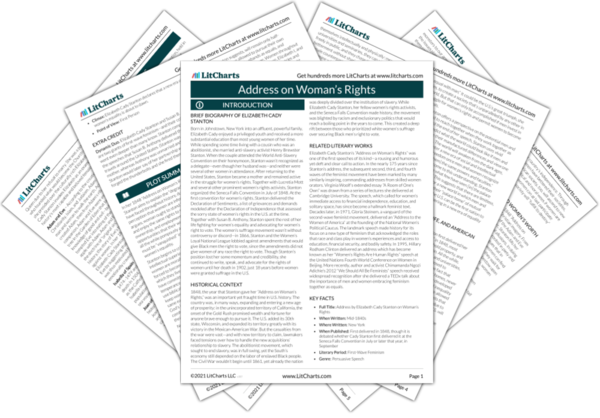Equality of the Sexes
In 1848, Elizabeth Cady Stanton delivered her “Address on Woman’s Rights,” in which she made the case that women were mocked simply for “dar[ing to] assert that woman stands by the side of man [as] his equal.” In many societies at this time, women were regarded as inferior to men in every way: intellectually, physically, and morally. Throughout her groundbreaking speech, Stanton picks apart men’s claims to superiority piece by piece—and in the process, she…
read analysis of Equality of the SexesWomen, Public Life, and American Prosperity
When Elizabeth Cady Stanton first delivered her “Address on Woman’s Rights” in 1848, most women around the world couldn’t vote or hold property, and only rarely could they pursue a real education. All the while, their male counterparts attended seminaries and universities, voted in elections, and lived public lives (as opposed to domestic ones). Stanton took great issue with the fact that American women were forced to languish in their homes, never meeting their full…
read analysis of Women, Public Life, and American ProsperityChristianity and Women’s Worth
Elizabeth Cady Stanton’s 1848 “Address on Woman’s Rights” is full of Christian imagery. From her unconventional analysis of the Adam and Eve story to her reverence for Saint Joan of Arc, Stanton fills her speech with religious references and biblical allusions. In doing so, the speech advocates for feminism that’s rooted in piety and the pursuit of Christian charity. The speech argues that in devoting themselves to the pursuit of holiness, women can…
read analysis of Christianity and Women’s Worth
Women’s Rights Around the World
Throughout her 1848 “Address on Woman’s Rights,” Elizabeth Cady Stanton references the various sufferings—and triumphs—of women all around the world. For instance, she discusses women kept as “slave[s]” in the “harems” of the East who choose to see their bondage as proof of their worth (though modern readers might find this description racist or condescending), as well as the legacies of monarchs like Queen Elizabeth of England and Queen Isabella of Spain. In this…
read analysis of Women’s Rights Around the World






